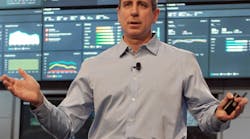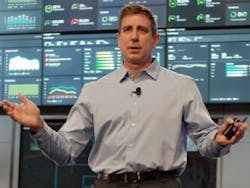“Honeywell Connected Plant allows us to seamlessly integrate process, assets and people, so we can make every day your best day of production.” Honeywell’s Jason Urso discussed how the company’s latest technologies allow all employees to contribute to gains in productivity, reliability and process safety.
Anyone only now becoming focused on digitalization, IIoT and Industrie 4.0 is late to the party by Honeywell’s standards, and not just a little late. “We’re on a 50-year journey of digitalization,” said Jason Urso, vice president and chief technology officer, Honeywell Process Solutions, “from TDC 3000, through the integrated operator console, software tools for advanced control and optimization, alarm management, and operator training—always enabling greater throughput, higher reliability and improved safety.”Urso spoke at the opening keynote session of the Honeywell Users Group (HUG) Americas conference this week in San Antonio. The 43rd HUG lists 1,300 attendees representing 32 countries.
“Now, the fourth generation of process control is bringing a new generation of benefits, and we see these in three areas,” Urso said:
- Capital projects are moving from mass customization to mass standardization with more efficient, automated engineering tools and systems.
- “Infinite longevity” is replacing rip-and-replace with upgrade-in-place, protecting intellectual property while enabling great new capabilities.
- Connecting data to knowledge is providing new, more effective ways to sustain maximum throughput.
Honeywell is expanding and supporting each of these three areas with new product introductions.
LEAP and capital project standardization
Five years ago, the LEAP methodology (for Lean Execution of Automation Projects) standardized I/O, facilitating the move from customized cabinets to modular cabinets based on I/O count. This allows the design process to be front-loaded and reduces the impact of late changes on project timelines. The C300 controller extracted software from hardware, allowing systems to be hosted in a cloud for design flexibility and remote access.
“Now we’re introducing the S300 SIL 3 safety logic solver, which extracts software from Safety Manager so we can design and validate safety systems without physical hardware, then land it on safety hardware with integrated safety I/O,” Urso said. “and we’ve added the highest level of cybersecurity on both the hardware and software.”
Experion has been encapsulated and virtualized, reducing server hardware needs by a factor of 10, allowing less frequent updates and making it easy to copy onto new hardware. Instead of people going away on-site for 12-18 months, working on physical equipment that’s also aging and may be nearing the end of its product lifecycle by startup, “we can engineer in the cloud, host a digital version of the system in a data center and work on it from anywhere in the world,” Urso said.
The factory acceptance test (FAT) is also changing form. “We have the opportunity to standardize it using digital twins of control, safety and edge PLCs,” Urso said. “We can plug into simulation to completely validate the whole system, using people located anywhere in the world—a virtual system FAT. Using standardized hardware further simplifies the hardware FAT. We can download the system and do a final test, and we’re done.”
The open, virtual engineering platform also provides the customer a digital copy for application engineering and control improvements. “There’s no need to manage physical apps, hardware or site upgrades. They can use the simulator, test the virtual system and load it,” Urso said.
Using automated commissioning instead of people in the field doing loop checks “improves productivity by a factor of 10,” Urso said. “The digital replicas are useful for the life of the system, to get projects done faster, with lower risk.”
The last migration
The Experion local control network (ELCN) has “infinite longevity, enabling the last migration,” Urso said. With the shifts from TDC 3000 to Experion Station to Enhanced High Performance Manager (EHPM) and Ethernet, “the legacy hardware is gone, and the intellectual property is preserved,” he said. ELCN emulates the remaining legacy hardware with software, eliminating component obsolescence and using software versions that can run on any platform. “Instead of rip and replace, you can upgrade the system in place, before your eyes,” Urso added.
“If you rip and replace controllers, you have to recreate the control strategies, which may be 25 years old. Can you do that? Instead, plug in EHPM modules and run the same strategies,” Urso said. “Recreate the displays? A typical plant might have 1,000, and 950 are never used. ELCN will preserve it all, and you can evolve and update only the ones you use going forward.”
Then there’s the downtime that rip and replace entails, plus the effort to retrain operators. “Rip and replace costs 10 to 20 times as much, with no quantifiable benefit,” Urso said.
Empowered operations
In our daily lives, knowledge is always improving, and we have instant access to the world’s best. Yet, in our plants, knowledge remains locked in people’s heads. “Can we give access to the best plant knowledge across the enterprise?” Urso asked. Industry needs to convert the data in spreadsheets, systems and people’s experience, to capture it and make it available. “Honeywell Connected Plant allows us to seamlessly integrate process, assets and people, so we can make every day your best day of production,” he said. “Everybody can be an expert at raising productivity and reliability, and we can make the next step change in process safety.”
For example, using Honeywell’s Profit Suite software can reduce variability, but benefits tend to decline over time as plant conditions change. Honeywell Connected Plant uses data to identify deviations and can apply UOP process expertise and plant experience to highlight opportunities for improvement. A new Unit Performance Monitor describes these opportunities in economic terms, say, $20,000 per day, to help plants prioritize and act on them. “Instead of degraded performance going unrecognized, it notifies operations and allows it to focus on the most profitable opportunities,” Usro said.
A new Asset Performance Dashboard provides a single, integrated dashboard for a unit, a plant or an enterprise, giving performance in context of the process. Using UOP process expertise, empirical and customer knowledge, the asset performance management system compares expected to actual performance, identifies faults and provides drill-down to see where the problem lies. “You can connect to experts, share information inside and outside the company and issue a work order directly from the console,” Urso said.
To get that work done right, on-demand virtual reality (VR) training can provide “immersive competency,” Urso added. Instead of training for jobs they don’t do or do so seldom they forget how, technicians can use VR to get last-minute preparation, to practice a job they’re about to do and to guide and verify the job as it’s performed.
Training is in the form of operator-guided task execution, using digital rather than written procedures, that can be delivered as a mobile app to an AR intelligent wearable—an eyepiece that allows hands-free procedure information and can transmit the operator’s view to a remote expert.
For those attending HUG, visit the on-site Knowledge Center to see these new products on display:
- Thermal IQ – Enables maintenance engineers and plant managers to more effectively monitor and manage their thermal process equipment, minimizing unplanned downtime and maximizing uptime.
- Uniformance Cloud Historian – This software-as-a-service cloud hosting solution for enterprise-wide data capture, visualization and analysis helps customers improve asset availability, optimize processes and increase plant uptime.
- Asset Performance Management – Integrates asset and process data for actionable insights to improve asset performance and plant profitability.
- Immersive Competency – This cloud-based simulation offering uses a combination of augmented reality (AR) and virtual reality (VR) to train plant personnel on critical industrial work activities, empowering them to directly improve plant performance, uptime, reliability and safety.
- Personal Gas Safety – This solution integrates with Honeywell’s leading plant control system to protect workers and speed emergency response in case of hazardous leaks or worker injury.
- Intelligent Wearables – This hands-free, wearable technology allows industrial workers to more safely, reliably and efficiently accomplish their tasks in the plant or the field. It uses a head-mounted visual display that responds to voice and brings live data, documents, work procedures, as well as health and safety information into view and can connect field workers with remote experts in real time.
- Experion Batch - Combines Experion distributed control, batch automation and new visualization technology for improved efficiency, quality and throughput.
- Measurement IQ for Gas - Provides measurement under control by transforming metering operations with 24/7 real-time condition-based monitoring.






